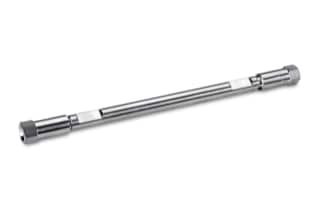
|
Chemistry |
C18 |
|
Separation Mode |
Reversed Phase |
|
Particle Substrate |
Silica |
|
pH Range Min |
2 pH |
|
pH Range Max |
8 pH |
|
Maximum Pressure |
6000 psi (415 Bar) |
|
Endcapped |
Yes |
|
Silanol Activity |
Low |
|
Particle Shape |
Spherical |
|
Particle Size |
3.5 µm |
|
Endfitting Type |
Waters |
|
Pore Size |
100 Å |
|
Format |
Column |
|
Surface Area |
340 |
|
System |
HPLC |
|
USP Classification |
L1 |
|
Inner Diameter |
2.1 mm |
|
Length |
100 mm |
|
Carbon Load |
16 % |
|
UNSPSC |
41115709 |
|
Brand |
SunFire |
|
Product Type |
Columns |
|
Units per Package |
1 pk |

SunFire C18 Column, 100Å, 3.5 µm, 2.1 mm X 100 mm, 1/pk
The SunFire C18 Column aids in the development of general-purpose methods at low pH. The SunFire C18 Column's C18 ligand is extremely retentive, particularly for basic chemicals, making the laboratory equipment ideal for purification and impurity profile studies. With the SunFire C18 Column, you receive the finest in particle and bonding knowledge for the best chromatographic performance in the industry.
After conducting significant research, Waters developed the SunFire Columns to give an industry-leading chromatographic performance, representing the best in particle and bonding expertise, thus making the SunFire C18 Columns state-of-the-art bonded C18 silica HPLC Columns. SunFire Columns are noted for their high chromatographic efficiency, low pH stability, and improved peak morphologies for charged analyte species.
The SunFire C18 Column is known for its high resolution, speed, and low backpressure. It also has features like outstanding sensitivity, large peak capacity, and ultra-low bleed, all of which work together to give you sharp peaks. This column's unique properties allow it to be employed in a wide range of mass spectrometry applications, making it an essential piece of lab equipment for any facility.
Unlike standard silica-based HPLC columns, the SunFire C18 Column has low pH stability, which increases the column's lifetime. Water's innovative packaging technology, state-of-the-art silica synthesis, bonding, and end-capping employed in the manufacturing process of the SunFire C18 Column give remarkable sensitivity, making it an excellent column to have in your lab.
You can browse through the Waters brochure or visit our website to shop for lab equipment as per your laboratory needs. The website also enables you to connect with our global client support staff to whom you can direct any queries and concerns.
We also recommend you to check out the SunFire C18 VanGuard Cartridge, 100Å, 3.5 µm, 2.1 mm X 5 mm, 3/pk;these SunFire C18 VanGuard Cartridges are primarily used to extend the analytical column lifetime and performance by removing particulate contamination from the mobile phase stream. This cartridge is optimized to protect all 2.1 mm and 3.0 mm I.D. SunFire C18 analytical columns containing 3.5 µm sorbent particles.
What Does Mass Spectrometry's Principle Represent
The basic idea behind mass spectrometry (MS) is to create ions from inorganic or organic substances using any applicable method, separate them by their mass to charge ratio (m/z), and detect them qualitatively and quantitatively using their respective m/z and abundance.